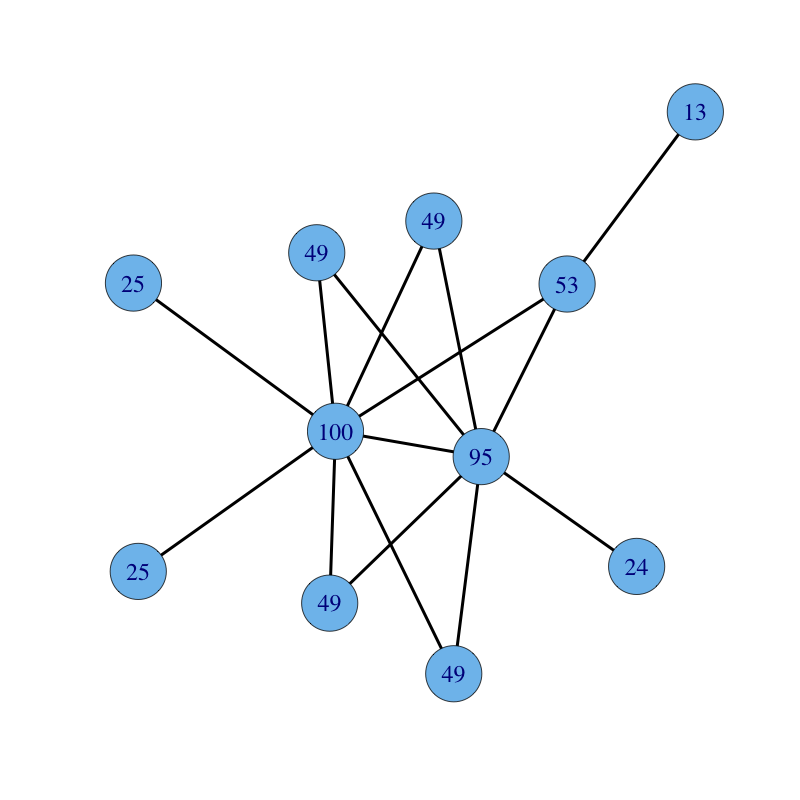
A natural extension of degree centrality is eigenvector centrality. In-degree centrality awards one centrality point for every link a node receives. But not all vertices are equivalent: some are more relevant than others, and, reasonably, endorsements from important nodes count more. The eigenvector centrality thesis reads:
A node is important if it is linked to by other important nodes.
Eigenvector centrality differs from in-degree centrality: a node receiving many links does not necessarily have a high eigenvector centrality (it might be that all linkers have low or null eigenvector centrality). Moreover, a node with high eigenvector centrality is not necessarily highly linked (the node might have few but important linkers).
Eigenvector centrality, regarded as a ranking measure, is a remarkably old method. Early pioneers of this technique are Wassily W. Leontief (The Structure of American Economy, 1919-1929. Harvard University Press, 1941) and John R. Seeley (The net of reciprocal influence: A problem in treating sociometric data. The Canadian Journal of Psychology, 1949). Read the full story full story.
The power method can be used to solve the eigenvector centrality problem. Let $m(v)$ denote the signed component of maximal magnitude of vector $v$. If there is more than one maximal component, let $m(v)$ be the first one. For instance, $m(-3,3,2) = -3$. Let $x^{(0)} = e$, where $e$ is the vector of all 1's. For $k \geq 1$:
until the desired precision is achieved. It follows that $x^{(k)}$ converges to the dominant eigenvector of $A$ and $m(x^{(k)})$ converges to the dominant eigenvalue of $A$. If matrix $A$ is sparse, each vector-matrix product can be performed in linear time in the size of the graph.
Let $$|\lambda_1| \geq |\lambda_2| \ldots \geq |\lambda_n|$$ be the eigenvalues of $A$. The power method converges if $|\lambda_1| > |\lambda_2|$. The rate of convergence is the rate at which $(\lambda_2 / \lambda_1)^k$ goes to $0$. Hence, if the sub-dominant eigenvalue is small compared to the dominant one, then the method quickly converges. If $A$ is a symmetric matrix, that is the graph of $A$ is undirected, then the eigenvalues of $A$ are all real numbers (in general, they might be complex numbers). In this case, it holds that the graph of $A$ is bipartite if and only if $\lambda_1$ and $-\lambda_1$ are eigenvalues of $A$. Hence, for bipartite graphs $\lambda_2 = - \lambda_1$ and hence $|\lambda_1| = |\lambda_2|$. It follows that the power method diverges on bipartite graphs. Lanczos and Jacobi-Davidson methods are faster alternatives to power method that converge also on bipartite graphs.
The built-in function eigen_centrality (R) computes eigenvector centrality (using ARPACK package).
A user-defined function eigenvector.centrality follows:
# Eigenvector centrality (direct method)
#INPUT
# g = graph
# t = precision
# OUTPUT
# A list with:
# vector = centrality vector
# value = eigenvalue
# iter = number of iterations
eigenvector.centrality = function(g, t=6) {
A = as_adjacency_matrix(g, sparse=FALSE);
n = vcount(g);
x0 = rep(0, n);
x1 = rep(1/n, n);
eps = 1/10^t;
iter = 0;
while (sum(abs(x0 - x1)) > eps) {
x0 = x1;
x1 = x1 %*% A;
m = x1[which.max(abs(x1))];
x1 = x1 / m;
iter = iter + 1;
}
return(list(vector = as.vector(x1), value = m, iter = iter))
}
An undirected connected graph with nodes labelled with their eigenvector centrality follows:
